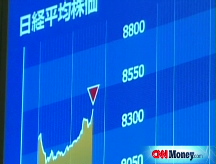Bailout in action: Lower lending rates
Lending rates continue to slide as government initiatives help keep borrowing costs down. Treasury prices trend higher on dour economic news.
NEW YORK (CNNMoney.com) -- As Bush administration officials defended the government's response to the credit crisis Tuesday, there is one immediate and tangible result of their efforts: lower borrowing costs.
The Federal Reserve and Treasury Department have poured billions of dollars into banks in an attempt to increase liquidity and encourage lending. The government has also unveiled other credit-boosting programs, including a purchasing program for short-term business debt and loans in exchanged for toxic assets as collateral.
As a result, lending rates have retreated from historical highs set last month when the credit crisis reached its peak. The 3-month Libor rate fell Tuesday to 2.22% from 2.24%, and the overnight Libor rate held steady at 0.4%, according to Bloomberg.com.
Libor, the London Interbank Offered Rate, is a daily average of interbank lending rates and a key barometer of liquidity in the credit market. More than $350 trillion in assets are tied to Libor.
In testimony before the House Financial Services committee Tuesday, Treasury Secretary Henry Paulson, Fed chief Ben Bernanke and FDIC chairwoman Sheila Bair defended the government's actions thus far, saying lower borrowing costs are a sign that market conditions are improving.
"Quotes for Libor ... have declined in relation to Treasury yields - indicating a slow thaw in the interbank lending market," said Bair in testimony. "While it is clearly too early to declare the end of the crisis in our financial markets, as a result of the coordinated response ... we are making steady progress in returning money and credit markets to a more normal state."
Rates had risen for a several days after Paulson said last week that the government would no longer buy up banks' troubled assets but rather take ownership stakes them. The rise proved to be just a bump in the road, as rates resumed their decline following the Treasury's announcement of more banks receiving liquidity injections.
On Monday, Treasury announced that it had dispersed $33.56 billion to 21 banks in a second round of payments as part of the $700 billion bailout program designed to boost the nation's banking system. The new distribution brings the total to $158.56 billion and 30 banks so far.
"Falling interbank rates are reflecting that the Fed is in there, putting money into banks," said Pierre Ellis, senior economist at Decision Economics. "Having a big pile of money lying around that the Treasury is authorized to use is making banks feel more comfortable about lending."
Market gauges: As rates held steady, so too did two gauges of banks' confidence in the credit market.
The Libor-OIS spread was up very slightly at 1.76 from 1.75. The spread measures the difference between actual borrowing costs and the expected targeted borrowing rate from the Fed. It is used as a gauge to determine how much cash is available for lending between banks. The bigger the spread, the less cash is available for lending.
Another indicator, the TED spread, fell slightly to 2.09 percentage points from 2.15 points. The TED spread measures the difference between the 3-month Libor and the 3-month Treasury bill, and is a key indicator of risk. The lower the spread, the more willing investors are to take risks.
Bonds: Treasury prices moved higher Tuesday as more dour economic data led investors to the perceived safety of government bonds.
Finding little in the way of return on investment in other markets, investors have recently placed conservative bets on the bond market. Recession fears and credit crisis anxiety have sent stocks falling in eight of 11 sessions thus far in November. Likewise, bonds have risen in seven of 10 sessions. The bond markets were closed on Veteran's Day (Nov. 11) while equities markets were open.
A government report on inflation for the month of October showed wholesale prices fell by 2.8%. The huge decline showed consumer demand for goods continues to fall sharply. Consumer prices rose 0.4%.
"It just confirms concerns about market safety," said Ellis. "Investors have a weak economic outlook, so they put what they have into safe assets."
As stocks churned Tuesday afternoon before ending the day mostly higher, recession fears remained the main driver, sending bonds higher.
In fact, bonds may continue to rise for the rest of the week, which will bring a number of other economic indicators that are expected to be equally as disappointing. Investors likely will continue to seek Treasurys as a safe-haven investment while stocks look for a market bottom.
The benchmark 10-year note rose 1-1/32 to 101-27/32, and its yield slipped to 3.54% from 3.66% late Monday. Bond prices and yields move in opposite directions.
The 2-year note was up 3/32 to 100-22/32, and its yield fell to 1.15%
The benchmark yield curve, the difference between the 2-year and the 10-year yield, narrowed to 2.39 percentage points, down from a five-year high of 2.54 points set Friday. The yield curve is a key measure of investor sentiment, with a higher curve indicating a weaker economic environment.
The 30-year bond rose 1-11/32 to 106-17/32, and its yield fell to 4.12% from 4.20%.
The yield on the 3-month bill, however, rose to 0.13% from 0.08%. The yield on the 3-month Treasury bill is closely watched as an immediate reading on investor confidence, with a lower yield indicating less optimism. Investors and money-market funds shuffle money into and out of the 3-month bill frequently as they assess risk in the rest of the marketplace. ![]()




